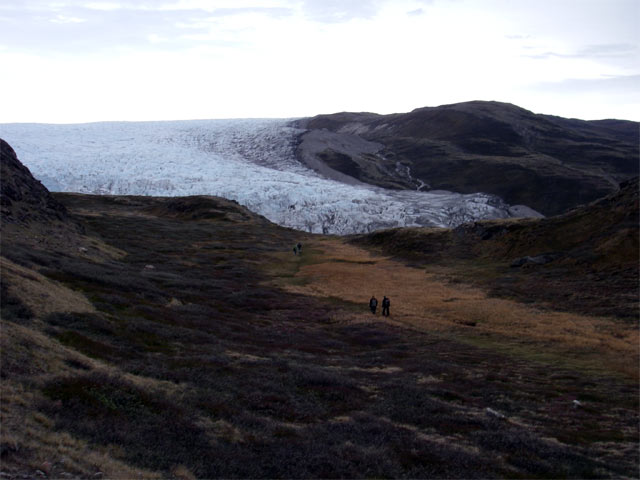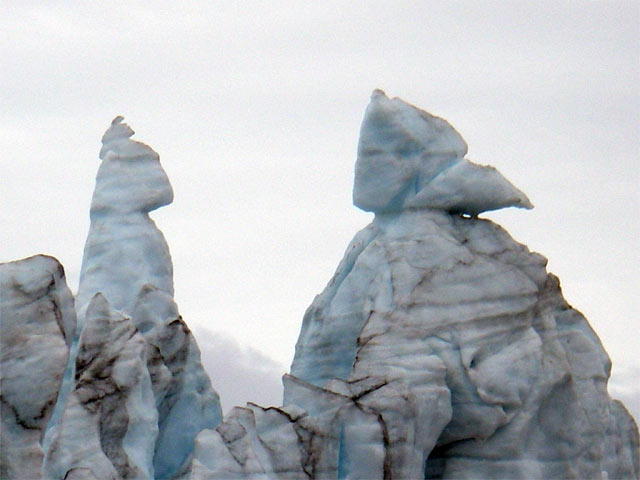( Log In ) Log In is for TREC Teachers & Researchers only
  |
| Kevin_McMahon |
 Jun 19 2006, 12:06 PM Jun 19 2006, 12:06 PM
Post
#1
|
 Advanced Member    Group: TREC Team Posts: 147 Joined: 12-April 06 Member No.: 25 |
High Temperature in Kangerlussuaq: +12 degrees Celsius
Low Temperature in Kangerlussuaq: +3 degrees Celsius Russell Glacier Our last full day in Greenland was filled with anticipation. We were finally going to visit Russell Glacier. Mike had never been to Russell Glacier so he was eager to see it too. Russell Glacier is located on the edge of the ice sheet. As you know from previous journal entries, I saw the edge of the ice sheet from the air but I didn’t have a chance to see it up close. We dressed warmly because we knew that temperatures on the glacier can be up to 10 degrees Celsius cooler than in Kangerlussauq. Few roads exist in Kangerlussauq. The road we took was a very bumpy dirt road. After a few kilometers, we passed the Sondie Arctic Desert Golf Course. It was strange seeing a golf course in Greenland. As you can see by the picture, it is quite different from the golf courses you may have seen in the United States.  Sondie Arctic Desert Golf Course After a bumpy 30 minute ride through some sandy patches and huge potholes, we came to a closed gate. Here, we grabbed our backpacks and began our 20 minute hike through the hills to the edge of the ice. The scenery was beautiful - rolling hills, curving banks of very cold lakes, and a tiny path created by previous visitors to the glacier.  Can you see the people in this photo? From the top of the hill, we could see a huge wall of ice. It seemed so close. Yet, the more we walked towards the glacier, the farther away it seemed to get. When we finally reached the edge of the glacier, we all stopped. “Whoa, this is unbelieveable”, I thought to myself. A gigantic 80 meter high wall of ice was in front of us. I felt like a little tiny ant next to it. The only thing separating us from ice was a narrow river that was clogged up with huge chunks of ice. We sat down on some nearby rocks for over 45 minutes staring at the glacier. It was like we were in an outdoor movie theater with a gigantic white screen. It was perfectly silent except for an occasional crashing of a chunk of ice as it got released from its icy home and the small trickle of water that poured out near the bottom of the glacier and landed in the river.  Chilling out and Watching Nature The shapes of the ice were very unique. As the ice calves (falls) off, some interesting shapes are left behind. I think the two columns of ice below look like two birds. What do you think? I imagine that if I came back again, the shapes would be totally different.  What do you think these ice columns look like? I was also mesmerized by the river of meltwater. When we first arrived, the river was clogged up with what appeared to be some chunks of ice. However, as more ice from upstream crashed into the pile of ice chunks, the ice began to break free and speed down the river. Huge chunks of ice, the size of small cars, were set free and went tumbling down this turbulent flow.  Can you see the ice piling up in the river? It doesn't look like big ice chunks because most of the ice is underwater. The ice sheet is so heavy that it makes the ground curve inward. Think about Earth being like a water balloon. When you touch the balloon with your finger, the surface bends inward. When you take your finger away, the water balloon returns to its original shape. The Earth’s surface behaves a lot like a water balloon. The surface bends in from the mass of all the ice. If the ice were to melt, the surface would slowly rise back to its original position. Scientists believe that some parts of the Earth’s surface that used to be covered in ice from the last ice age are still rising. Did you know that the ice sheet is in constant motion? We couldn’t feel the ice sheet moving when we were at Summit camp. However, when you stand at the edge of the ice sheet, you get a view of just how powerful the ice is when it moves. Russell Glacier is moving at a speed of about 25 meters a year. Can you imagine what happens to rocks when this heavy ice sheet moves over them? If you guessed that the ice crushes them, you are correct. The ice is so heavy that it pulverizes rock into powder as it moves forward. There is a lot of very fine powdery gray sediment in the river from this pulverized rock. I hope you get a chance to see a glacier up close like I did. Do you know where you can still find glaciers in the United States? The hike back to the car was very beautiful. Here is a picture of what it looked like. Can you see our road?  Hiking back from Russell Glacier On the drive back to Kangerlussuaq, we kept our eyes open for herds of musk oxen and caribou. We didn’t see any caribou but the hills across the river were dotted with musk oxen. Arctic Fact of the Day: Caribou skins are believed to have the best insulation by weight ratio of any material, artificial or natural. |
| Tracy_Alley |
 Jun 24 2006, 06:56 AM Jun 24 2006, 06:56 AM
Post
#2
|
 Advanced Member    Group: TREC Team Posts: 43 Joined: 12-April 06 Member No.: 26 |
I enjoyed all of your gorgeous pictures. You experienced so many awesome sites on your journey. What a trip!
Great journals! |
  |
1 User(s) are reading this topic (1 Guests and 0 Anonymous Users)
0 Members:

|
NSF Acknowledgment & Disclaimer | Time is now: 16th November 2024 - 08:06 AM |
Invision Power Board
v2.1.7 © 2024 IPS, Inc.








